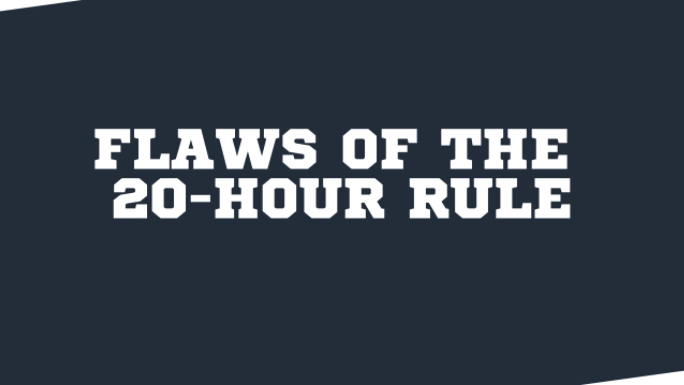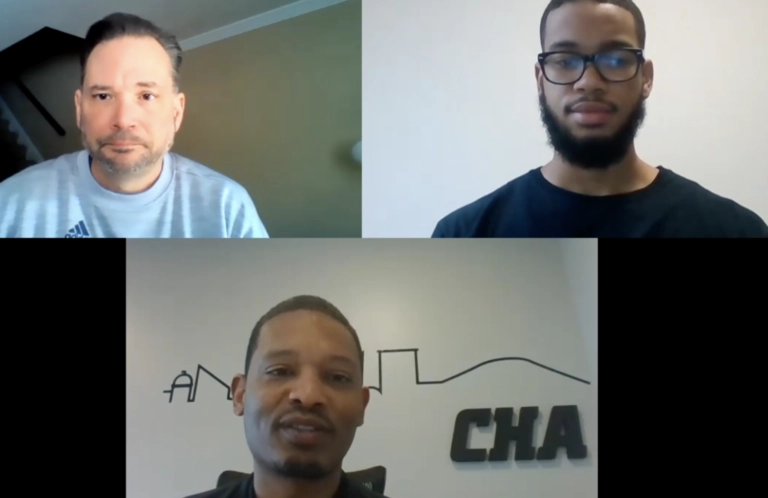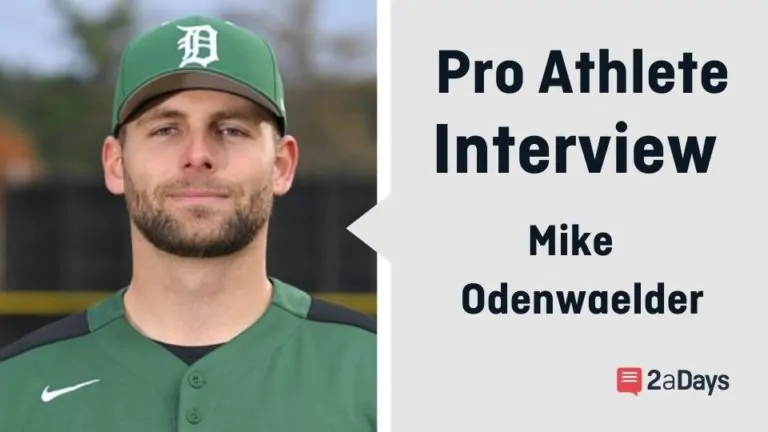Every prospective athlete understands that life as a college athlete is time-consuming. I remember during my time in the NCAA, telling recruits that they would have to learn time management skills once they started competing, which, while not technically untrue, was the understatement of the century. A teammate of mine used to tell recruits about the college athlete triangle: “As a college athlete, you want three things: good grades and athletic performances, a social life, and sleep. You can only pick two.”
Related: Rate your Coaches
My teammate was dead-on. Time works differently for college athletes, no thanks to the so-called limitations the NCAA places on practice and competition time. These measures are detailed in the 2019-2020 version of the Division I Manual under Bylaw 17.1.7.1, which states:
“A student-athlete's participation in countable athletically related activities shall be limited to a maximum of four hours per day and 20 hours per week.”
Related: Rate your Facilities
Before I get into the shortfalls of the 20-hour rule, we need to rewind to Bylaw 17.02.14, which lists required athletically related activities, defined as “any activities, including those that are countable in the daily and weekly limitations, that are required of a student-athlete.” These activities are not considered countable toward the NCAA's 20-hour limit (the NCAA published a chart that illustrates the differences between countable/noncountable time here), and the manual then provides a non-exhaustive list of required (but non-countable) activities:
· Compliance meetings
· Organized team promotional activities
· Recruiting activities, including student-host duties
· Media activities
· Fundraising events
· Community service events
· Team-building activities
· Travel to and from away-from-home competition
In short, activities such as scheduled practices, competition days, and film sessions are considered countable, while the activities listed above are not. The NCAA requires coaches to give athletes at least one day off per week (which athletes are not required to take—they can still work out if the workout is considered voluntary). Travel days can also count as days off (for nonautonomy schools), if no mandatory countable athletically related activities take place that day, or 24 hours following a return trip that takes place between midnight and 5:00 AM.
Confused? That's understandable. To clear things up, here's a glimpse of an itinerary from my sophomore year as a distance runner at Western Kentucky University covering a four-day track trip from WKU to Stanford University. This time around, I played coach and logged the hours. Here are my calculations, following the NCAA's time limit guidelines for nonautonomy schools:
Related: Rate Western Kentucky University
Day 1 (Wednesday)
5:00-6:00 AM CST: Wake up/ “voluntary” shakeout run (0 hr. of countable athletically-related time)
6:00-7:00 AM CST: Shower/breakfast, walk to stadium to find team vans
7:00-8:00 AM CST: Drive to Nashville airport (0 hrs. of countable athletically-related time)
10:00 AM CST-3:00 PM PST: Fly to San Francisco (0 hrs. of countable athletically-related time)
3:00-4:00 PM PST: Drive from airport to hotel (0 hrs. of countable athletically-related time)
5:00-9:00 PM PST: Dinner/downtime/bed.
Total countable athletically-related time: 0 hours
Actual time spent travelling/competing: 9 hours
*If, as a coach, I deem an athlete's workout “voluntary,” this travel day could also be considered a day off, according to Bylaw 17.1.7.4.1, which states “A travel day related to athletics participation may be considered as a day off, provided no countable athletically related activities occur during that day.” Hence, day one could potentially count as zero hours toward the 20-hour limit. Even if my run was mandatory, at most, day one would only be countable as one hour of countable time, since travel to and from competition doesn't count.
Related: Rate your Campus Visits
Day 2 (Thursday)
8:00-9:00 AM PST: Shakeout run (1 hr. of countable athletically-related time)
9:00AM-12:00PM PST: Shower/breakfast/study time
12:00-5:00PM: Lunch/sightseeing
6:00PM-7:00PM: Dinner
7:30-10:00PM: Study time/bed
Total countable athletically-related time: 1 hour
Actual time spent traveling/competing: 1 hour
Day 3 (Competition Friday)
9:00-9:30 AM PST: Shakeout run (0.5 hr. countable athletically-related time)
9:30AM-6:00PM: Shower, meals, study, race prep
6:00-6:30: Drive to track (0.5 hr. countable athletically-related time)
7:00-9:00 PM PST: warm-up/ 10k race/cool down (2 hrs countable athletically-related time)
9:30-10:00PM PST: drive back to hotel (0.5 hrs countable athletically-related time)
11:00: bed
Total countable athletically-related time: 3 hours*
Actual time spent travelling/competing: 3.5 hours
*Here is another tricky element of the 20-hour rule, outlined in Bylaw 17.1.7.3.2, which states “All competition and any associated athletically related activities on the day of competition shall count as three hours regardless of the actual duration of these activities.” That knocks 30 minutes off the countable athletically-related time for this day.
Day 4/5 (Saturday & Sunday)
7:00-8:00 AM PST: Shakeout run (1 hr. countable athletically-related time)
8:00-11:00 AM PST: Shower/breakfast/pack/study
11:00-12:00 AM PST: Drive to airport (0 hrs. countable athletically-related time)
2:00 PM PST-10:00 PM CST: Fly back to Nashville (0 hrs. countable athletically-related time)
11:00 PM CST- 12:00 AM CST: Drive home from airport (0 hr. countable athletically-related time)
1:00 AM CST: Bed
Total countable athletically-related time: 1 hour
Actual time spent travelling/competing: 9 hours
Here are the grand totals for my four-day trip
Total countable athletically-related time for the entire trip: 5 hours
Actual time spent travelling/competing: 22.5 hours
As you can see, I ran (no pun intended) 2.5 hours over the NCAA's 20-hour cap over the span of four days, not seven, but the trip only counted as 5 hours. Discrepancy aside, there are a few other important things to keep in mind when considering countable athletically-related time:
First, this was a competition week, and distance runners typically only travel/compete once per week, as compared to, say, baseball or basketball players who may take multiple trips, and compete multiple times, as do many sprinters, throwers, and other track athletes that compete in multiple events. Distance runners like me also never had to worry about media appearances, or team promotional activities (which don't count toward time limits, anyway), because we weren't as flashy as the football or men's basketball team.
However, a key stipulation is that distance runners also compete year-round (cross country in the fall, indoor track in the winter, and outdoor track in the spring), so our countable athletically-related time is spread out over the entire course of the athletic year. This illustrates a unique dynamic within the NCAA: countable athletically-related time looks different for all athletes in all sports, but, according to the NCAA's own research, rarely do college athletes only put in twenty hours per week. In actuality, the numbers average closer to thirty-plus hours at the Division I level.
Second, my realistic 22.5-hour count is only based on the time traveling, training, and competing in the latter half of the week. Throw in the other three days of training (two hours of practice apiece), and my count would creep much closer to thirty hours. That total also does not include time spent traveling to and from practice, or time spent in the training room stretching, rehabbing, seeing the trainer, or spending time in the cold tank, which oftentimes took up to another hour per day. Realistically, my total hour count would be approximately 30.5 hours, roughly ten hours over the NCAA's limit, and closer to the time that I would spend in a full-time job than the “avocation” the NCAA makes collegiate competition out to be.
However, thanks to the standards set by the 20-hour rule, my total weekly count would be closer to 9 hours, not even half the NCAA's limit. Therefore, my coaches could have pushed me much harder if they wanted to, and some coaches do take advantage of this loophole, which is why athletes have historically attempted to unionize—being a college athlete resembles the workload of a full-time job without the employee benefits.
Related: How the NCAA Can Address Mental Health
The kind of fatigue involved in a trip like this makes it hard to focus on school (plus, I missed several days of class over this trip, and had to make up assignments, and spend extra effort communicating with my professors remotely). Any of my time spent studying on a plane, in an airport/hotel room, or leading up to a race was always scatterbrained at best, and a far cry from the “student-athlete” mentality the NCAA so strongly purports. In actuality, the way that countable athletically-related time is calculated by coaches, and experienced by college athletes can easily distract athletes from the true purpose of their competition: earning a degree.
If college athletes truly are amateurs, then their workload should look less like a full-time job, and more like a means to an education. That's precisely why the NCAA needs to strictly regulate the amount of time college athletes spend travelling, training, and competing, which would require a complete overhaul of the 20-hour rule and countable athletically-related activity. Until that happens, prospective athletes should understand the true strains of life in the NCAA before they sign any letters of intent or scholarship papers by checking out our Daily Grind column.
To keep up with NCAA policy insights, follow Katie Lever on Twitter and Instagram: @leverfever
Have an idea for a story or a question you need answered? Want to set up an interview with us? Email us at [email protected]
* Originally published on August 31, 2021, by Katie Lever, Ph. D







